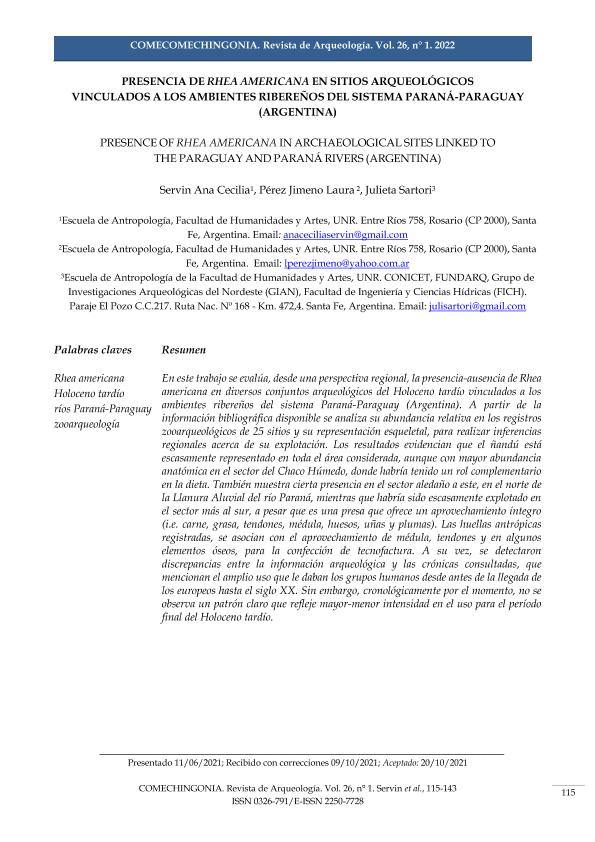Artículo
En este trabajo se evalúa, desde una perspectiva regional, la presencia-ausencia de Rhea americana en diversos conjuntos arqueológicos del Holoceno tardío vinculados a los ambientes ribereños del sistema Paraná-Paraguay (Argentina). A partir de la información bibliográfica disponible se analiza su abundancia relativa en los registros zooarqueológicos de 25 sitios y su representación esqueletal, para realizar inferencias regionales acerca de su explotación. Los resultados evidencian que el ñandú está escasamente representado en toda el área considerada, aunque con mayor abundancia anatómica en el sector del Chaco Húmedo, donde habría tenido un rol complementario en la dieta. También muestra cierta presencia en el sector aledaño a este, en el norte de la Llanura Aluvial del río Paraná, mientras que habría sido escasamente explotado en el sector más al sur, a pesar que es una presa que ofrece un aprovechamiento íntegro (i.e. carne, grasa, tendones, médula, huesos, uñas y plumas). Las huellas antrópicas registradas, se asocian con el aprovechamiento de médula, tendones y en algunos elementos óseos, para la confección de tecnofactura. A su vez, se detectaron discrepancias entre la información arqueológica y las crónicas consultadas, que mencionan el amplio uso que le daban los grupos humanos desde antes de la llegada de los europeos hasta el siglo XX. Sin embargo, cronológicamente por el momento, no se observa un patrón claro que refleje mayor-menor intensidad en el uso para el período final del Holoceno tardío. This work evaluates, from a regional perspective, the presence-absence of Rhea americana in 25 late Holocene archaeological sites linked to the riparian environments of the Paraná-Paraguay system (Argentina). Based on the available bibliographic information, a study about her skeletal representation and his relative abundance within the birds’ category were made in order to make regional inferences about its exploitation. The results show that the rhea is poorly represented in the entire area considered, although with greater abundance and anatomical completeness in the area of the Humid Chaco, where it would have had a complementary role in the diet. It also has a certain presence in the sector adjacent to this, in the north of the Alluvial Plain of the Paraná River, while it would have been scarcely exploited in the sector further south, despite the fact that it is a prey that offers full use (i.e. meat, fat, tendons, marrow, bones, nails and feathers). The cut marks registered are associated with the use of marrow, tendons and some bone elements for the fabrication of technofacture. In turn, discrepancies were detected between the archaeological information and the chronicles consulted, which mention the wide use that human groups gave it from before the arrival of Europeans until the 20th century. However, chronologically at the moment, there is no clear pattern that reflects greater-less intensity in use for the final late Holocene period.
Presencia de Rhea americana en sitios arqueológicos vinculados a los ambientes ribereños del sistema Paraná-Paraguay (Argentina)
Título:
Presence of Rhea americana in archaeological sites linked to the Paraguay and Paraná rivers (Argentina)
Fecha de publicación:
12/2021
Editorial:
Centro de Estudios Históricos "Profesor Carlos S.A. Segreti"
Revista:
Comechingonia
ISSN:
0326-7911
e-ISSN:
2250-7728
Idioma:
Español
Tipo de recurso:
Artículo publicado
Clasificación temática:
Resumen
Palabras clave:
Rhea americana
,
Holoceno tardío
,
Ríos Paraná-Paraguay
,
Zooarqueología
Archivos asociados
Licencia
Identificadores
Colecciones
Articulos(CCT - SANTA FE)
Articulos de CTRO.CIENTIFICO TECNOL.CONICET - SANTA FE
Articulos de CTRO.CIENTIFICO TECNOL.CONICET - SANTA FE
Citación
Servin, Ana Cecilia; Pérez Jimeno, Laura Teresita; Sartori, Julieta Isabel; Presencia de Rhea americana en sitios arqueológicos vinculados a los ambientes ribereños del sistema Paraná-Paraguay (Argentina); Centro de Estudios Históricos "Profesor Carlos S.A. Segreti"; Comechingonia; 26; 1; 12-2021; 115-143
Compartir
Altmétricas




